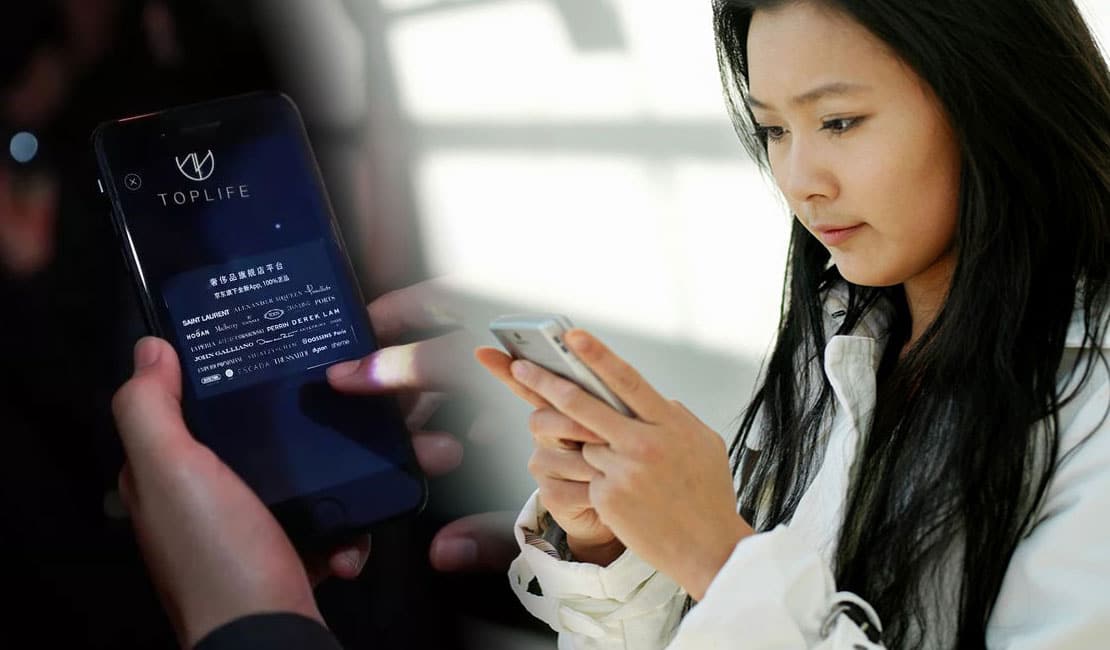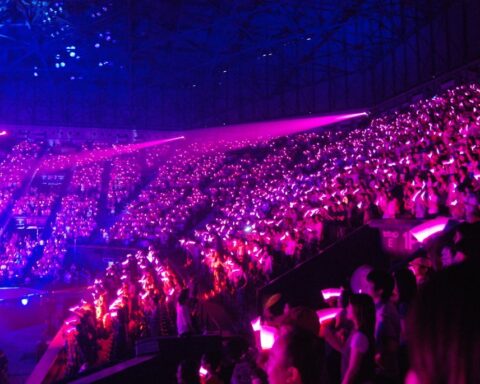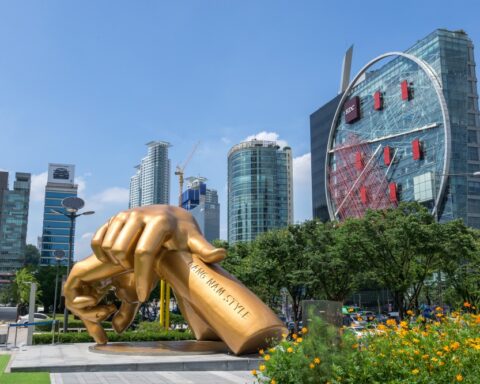[vc_row njt-role=”people-in-the-roles” njt-role-user-roles=”administrator,editor,author,armember”][vc_column][vc_column_text]
In the words of Bain & Co, it is “another China” that is revealing itself to luxury brands, following the drastic restrictions imposed by Beijing until December 2022. For its part, the Chinese luxury e-commerce market is showing signs of normalization, not to say deceleration, disturbing a lavish odyssey begun in 2017.
While the online luxury ecosystem is now almost mature, fiercer than ever competition is forcing brands and platforms to explore other value propositions around immersive experiences and ultra-customization. With its Tmall Luxury Pavilion platform – tailored to the desiderata of the big houses – and despite a half-hearted Single’s Day, Alibaba maintains its leadership. But sharp-minded challengers, such as JD.com and Farfetch China, are moving up the luxury ladder, making a shift in the balance of power credible. As a backlash to the zero covid policy and the urban confinement suffered by millions of Chinese, digital fatigue also seems to be taking hold at the beginning of 2023. This is an incentive to strengthen the retail experience in stores and to reinvent live shopping.
Towards a different China in luxury e-commerce
For more than a decade, the Middle Kingdom has known how to reward the digital ubiquity of the major players in international luxury. However, the Chinese market, leader of the global e-commerce, hides another truth: no one can enter it without a network of physical stores in addition to the main e-commerce and social commerce platforms.
Thus, there is no luxury brand that does not have its physical flagship store in the most popular streets of major cities, its Wechat mini store, its official Chinese-language e-shop, its virtual flagship on Tmall and its page on Xiaohongshu (RED).
Yet online, the euphoria that began in 2017 – with the opening of Louis Vuitton’s virtual store – seems well behind, as evidenced by the mood of the latest Single’s Day 2022.
This annual event celebrating singles – the temple of online bargains – launched by the Alibaba Group remains the must-attend event of the Chinese e-commerce market, and even more so for the major luxury houses. However, the preservation of their brand equity dissuades them, for a large part, to participate in this race to the discounts. The event, which is entering its 22nd year, seems to have reached its sales plateau.
The Single Day (or Double 11) – representing no less than 4 times the usual turnover of the platforms – is known as a very big contributor to the country’s e-commerce activity. As a reminder, in 2021, the total online sales in the Chinese market will represent more than $1.39 trillion, an increase of 12% compared to the previous year, according to a BCG study.
The Chinese e-commerce market is expected to grow by 10.4% in 2022, according to GlobalData forecasts. That is to say a downward trend that is confirmed, judging by the growth rate of 15% recorded in 2021.
The Chinese e-commerce had contributed to more than half of the country’s retail sales with a turnover of $ 1,543 billion, placing it ahead of the United States.
For once, while a peak in sales was recorded in 2021, Alibaba and JD.com preferred to remain discreet in 2022 on their high-profile business volume (GMV) during the Single Day, contenting themselves with confirming results aligned with 2021. As a reminder, the previous edition had benefited from a GMV of $1.13 trillion, or $150 million more than in 2020. Only the number of participating brands and the size of the offer were communicated. For comparison, JD.com’s GMV was $244 billion in 2021. However, this GMV index has the flaw of not counting refunds or product returns.
The sluggish economic environment and a rationalization of usage after long months of confinement have taken their toll on buying fever. “Consumer confidence has suffered greatly from the restrictions,” as Chloe Reuter, a founding partner of the marketing agency Gusto Collective“, told the New York Times.
Anaïs Bournonville, Head of Luxury Division at GMA, a marketing agency specializing in the Chinese market, explains the lackluster Single’s Day by two phenomena: an inflation of livestreaming sessions as well as a weariness of bargain hunting. According to her, “lately it is the discounts and not the desire or a real need that have dictated their choices. This feeling of overflow has seen the appearance of anti-consumer groups on Weibo: a first in the country“.
Outside of luxury, confinements have made online shopping for fresh products more comfortable, while health has become more important.
The New York Times points out that the unemployment rate of young people peaks at 20% while the economic growth of the country is well below the forecasts of the central government.
Moreover, unlike 2020 and 2021, the Zero COVID policy has more severely affected e-commerce, especially with the very strict confinement of the country’s financial center, Shanghai, making it considerably more difficult to deliver products to its 26 million inhabitants.
Unprecedented decline
Although the sector is considered ultra-resilient, online sales of luxury goods have not been immune to this downward trend. In its 2022 report – which does not include the fourth quarter – the American firm Npd notes a drop in luxury goods sales of -1% compared to the previous year ($1.2 billion). Although it has yet to be confirmed, this decrease – however modest – is nonetheless unprecedented for the sector.
In detail, Npd notes that the luxury e-commerce market in China has seen its sales increase by 30% in the first quarter of 2022 and by 1% in the first half of the year, compared to the same periods in 2021. Sales declined by 14% and 5% in the second and third quarters of 2022, respectively.
“This year, we have observed a real shift from luxury e-commerce purchases to investment products, which are part of a long time” as Anaïs Bournonville states. She adds, “Hard luxury has benefited, especially jewelry, but watches with low price positioning have been punished.
This expert of the Chinese luxury market also notes a new attraction for interior decoration with a real trend on the e-content application Xiaohongshu to transform one’s home into a cocoon. She also notes a real demand for everything related to personal care, and in particular niche perfumery, with brands like Frédéric Malle and Byredo.
In addition, the luxury e-commerce sector is becoming increasingly concentrated, particularly following the bankruptcy of domestic e-commerce platforms such as Secoo, a specialist in second-hand luxury goods, which has been established in the country since 2008. A growing polarization is taking place between the generalist Chinese e-commerce players Alibaba and JD.com, on the one hand, and specialized, more exclusive and editorialized Western platforms such as Farfetch China and Net-a-porter, on the other.
Alibaba’s leadership, through Tmall Luxury Pavilion – which remains the largest e-commerce platform dedicated to luxury goods in China – is being increasingly challenged by its main challenger JD.com.
The latter now manages to seduce international luxury brands. It has itself developed a new section on the remnants of its fashion and lifestyle offer: JD Luxury.
On their side, luxury brands, thanks to their digital marketing efforts accelerated during the covid, trust more and more local e-commerce players, masters in the art of logistics and data marketing.
3D customer experience and services
A trompe-l’oeil vision, the year 2022 seemed similar to the previous ones.
The excitement on the networks is still there while new luxury brands have once again announced their arrival on the country’s star platforms.
Thus, three new flagship brands of the LVMH group – Bulgari, Berluti and Céline – have joined Tmall Luxury Pavilion alongside other established brands such as Brunello Cucinelli, Moncler, Jil Sander and Amiri, bringing the offer to more than 200 luxury brand partners.
For its part, JD.com has inaugurated on its platform the virtual flagships of a first House of the Kering group (the jeweler Qeelin) and of a ninth House of the LVMH group (Fendi).
These two announcements are far from insignificant, since until now Tmall Luxury Pavilion was one of the few e-commerce sites where luxury brands dared to venture.
It must be said that the challenger JD.com – a pioneer in same-day delivery, specializing in electronic equipment – has managed to improve its image.
After a first unsuccessful attempt in the luxury world with its Toplife platform in 2017 – sold to merge with Farfetch China – JD.com launched its Plus Luxury loyalty program this summer. This service offers its members discount coupons valid with 300 major brands but above all premium services such as a high-end dry cleaner, invitations to exclusive offline events or even a white glove courier delivery. To the point that JD.com is on its way to becoming a major player in the online sale of luxury goods.
Faced with this increased competition, the leader Tmall Luxury Pavilion could not stand still and has since beefed up the quality of its services for major brands.
To be continued…
Read also >Chinese tourism recovery: what opportunities for luxury?
Featured photo : ©Press[/vc_column_text][/vc_column][/vc_row][vc_row njt-role=”not-logged-in”][vc_column][vc_column_text]
In the words of Bain & Co, it is “another China” that is revealing itself to luxury brands, following the drastic restrictions imposed by Beijing until December 2022. For its part, the Chinese luxury e-commerce market is showing signs of normalization, not to say deceleration, disturbing a lavish odyssey begun in 2017.
While the online luxury ecosystem is now almost mature, fiercer than ever competition is forcing brands and platforms to explore other value propositions around immersive experiences and ultra-customization. With its Tmall Luxury Pavilion platform – tailored to the desiderata of the big houses – and despite a half-hearted Single’s Day, Alibaba maintains its leadership. But sharp-minded challengers, such as JD.com and Farfetch China, are moving up the luxury ladder, making a shift in the balance of power credible. As a backlash to the zero covid policy and the urban confinement suffered by millions of Chinese, digital fatigue also seems to be taking hold at the beginning of 2023. This is an incentive to strengthen the retail experience in stores and to reinvent live shopping.
Towards a different China in luxury e-commerce
For more than a decade, the Middle Kingdom has known how to reward the digital ubiquity of the major players in international luxury. However, the Chinese market, leader of the global e-commerce, hides another truth: no one can enter it without a network of physical stores in addition to the main e-commerce and social commerce platforms.
Thus, there is no luxury brand that does not have its physical flagship store in the most popular streets of major cities, its Wechat mini store, its official Chinese-language e-shop, its virtual flagship on Tmall and its page on Xiaohongshu (RED).
Yet online, the euphoria that began in 2017 – with the opening of Louis Vuitton’s virtual store – seems well behind, as evidenced by the mood of the latest Single’s Day 2022.
This annual event celebrating singles – the temple of online bargains – launched by the Alibaba Group remains the must-attend event of the Chinese e-commerce market, and even more so for the major luxury houses. However, the preservation of their brand equity dissuades them, for a large part, to participate in this race to the discounts. The event, which is entering its 22nd year, seems to have reached its sales plateau.
The Single Day (or Double 11) – representing no less than 4 times the usual turnover of the platforms – is known as a very big contributor to the country’s e-commerce activity. As a reminder, in 2021, the total online sales in the Chinese market will represent more than $1.39 trillion, an increase of 12% compared to the previous year, according to a BCG study.
The Chinese e-commerce market is expected to grow by 10.4% in 2022, according to GlobalData forecasts. That is to say a downward trend that is confirmed, judging by the growth rate of 15% recorded in 2021.
The Chinese e-commerce had contributed to more than half of the country’s retail sales with a turnover of $ 1,543 billion, placing it ahead of the United States.
For once, while a peak in sales was recorded in 2021, Alibaba and JD.com preferred to remain discreet in 2022 on their high-profile business volume (GMV) during the Single Day, contenting themselves with confirming results aligned with 2021. As a reminder, the previous edition had benefited from a GMV of $1.13 trillion, or $150 million more than in 2020. Only the number of participating brands and the size of the offer were communicated. For comparison, JD.com’s GMV was $244 billion in 2021. However, this GMV index has the flaw of not counting refunds or product returns.
The sluggish economic environment and a rationalization of usage after long months of confinement have taken their toll on buying fever. “Consumer confidence has suffered greatly from the restrictions,” as Chloe Reuter, a founding partner of the marketing agency Gusto Collective“, told the New York Times.
Anaïs Bournonville, Head of Luxury Division at GMA, a marketing agency specializing in the Chinese market, explains the lackluster Single’s Day by two phenomena: an inflation of livestreaming sessions as well as a weariness of bargain hunting. According to her, “lately it is the discounts and not the desire or a real need that have dictated their choices. This feeling of overflow has seen the appearance of anti-consumer groups on Weibo: a first in the country“.
Outside of luxury, confinements have made online shopping for fresh products more comfortable, while health has become more important.
The New York Times points out that the unemployment rate of young people peaks at 20% while the economic growth of the country is well below the forecasts of the central government.
Moreover, unlike 2020 and 2021, the Zero COVID policy has more severely affected e-commerce, especially with the very strict confinement of the country’s financial center, Shanghai, making it considerably more difficult to deliver products to its 26 million inhabitants.
Unprecedented decline
Although the sector is considered ultra-resilient, online sales of luxury goods have not been immune to this downward trend. In its 2022 report – which does not include the fourth quarter – the American firm Npd notes a drop in luxury goods sales of -1% compared to the previous year ($1.2 billion). Although it has yet to be confirmed, this decrease – however modest – is nonetheless unprecedented for the sector.
In detail, Npd notes that the luxury e-commerce market in China has seen its sales increase by 30% in the first quarter of 2022 and by 1% in the first half of the year, compared to the same periods in 2021. Sales declined by 14% and 5% in the second and third quarters of 2022, respectively.
“This year, we have observed a real shift from luxury e-commerce purchases to investment products, which are part of a long time” as Anaïs Bournonville states. She adds, “Hard luxury has benefited, especially jewelry, but watches with low price positioning have been punished.
This expert of the Chinese luxury market also notes a new attraction for interior decoration with a real trend on the e-content application Xiaohongshu to transform one’s home into a cocoon. She also notes a real demand for everything related to personal care, and in particular niche perfumery, with brands like Frédéric Malle and Byredo.
[…][/vc_column_text][vc_cta h2=”This article is reserved for subscribers.” h2_font_container=”tag:h2|font_size:16|text_align:left” h2_use_theme_fonts=”yes” h4=”Subscribe now !” h4_font_container=”tag:h2|font_size:32|text_align:left|line_height:bas” h4_use_theme_fonts=”yes” txt_align=”center” color=”black” add_button=”right” btn_title=”I SUBSCRIBE !” btn_color=”danger” btn_size=”lg” btn_align=”center” use_custom_fonts_h2=”true” use_custom_fonts_h4=”true” btn_button_block=”true” btn_custom_onclick=”true” btn_link=”url:https%3A%2F%2Ftest2023.luxus-plus.com%2Fen%2Fsubscriptions-and-newsletter-special-offer-valid-until-september-30-2020-2-2%2F”]Get unlimited access to all articles and live a new reading experience, preview contents, exclusive newsletters…
Already have an account ? Please log in.[/vc_cta][vc_column_text]Featured photo : ©Press [/vc_column_text][/vc_column][/vc_row][vc_row njt-role=”people-in-the-roles” njt-role-user-roles=”subscriber,customer”][vc_column][vc_column_text]
In the words of Bain & Co, it is “another China” that is revealing itself to luxury brands, following the drastic restrictions imposed by Beijing until December 2022. For its part, the Chinese luxury e-commerce market is showing signs of normalization, not to say deceleration, disturbing a lavish odyssey begun in 2017.
While the online luxury ecosystem is now almost mature, fiercer than ever competition is forcing brands and platforms to explore other value propositions around immersive experiences and ultra-customization. With its Tmall Luxury Pavilion platform – tailored to the desiderata of the big houses – and despite a half-hearted Single’s Day, Alibaba maintains its leadership. But sharp-minded challengers, such as JD.com and Farfetch China, are moving up the luxury ladder, making a shift in the balance of power credible. As a backlash to the zero covid policy and the urban confinement suffered by millions of Chinese, digital fatigue also seems to be taking hold at the beginning of 2023. This is an incentive to strengthen the retail experience in stores and to reinvent live shopping.
Towards a different China in luxury e-commerce
For more than a decade, the Middle Kingdom has known how to reward the digital ubiquity of the major players in international luxury. However, the Chinese market, leader of the global e-commerce, hides another truth: no one can enter it without a network of physical stores in addition to the main e-commerce and social commerce platforms.
Thus, there is no luxury brand that does not have its physical flagship store in the most popular streets of major cities, its Wechat mini store, its official Chinese-language e-shop, its virtual flagship on Tmall and its page on Xiaohongshu (RED).
Yet online, the euphoria that began in 2017 – with the opening of Louis Vuitton’s virtual store – seems well behind, as evidenced by the mood of the latest Single’s Day 2022.
This annual event celebrating singles – the temple of online bargains – launched by the Alibaba Group remains the must-attend event of the Chinese e-commerce market, and even more so for the major luxury houses. However, the preservation of their brand equity dissuades them, for a large part, to participate in this race to the discounts. The event, which is entering its 22nd year, seems to have reached its sales plateau.
The Single Day (or Double 11) – representing no less than 4 times the usual turnover of the platforms – is known as a very big contributor to the country’s e-commerce activity. As a reminder, in 2021, the total online sales in the Chinese market will represent more than $1.39 trillion, an increase of 12% compared to the previous year, according to a BCG study.
The Chinese e-commerce market is expected to grow by 10.4% in 2022, according to GlobalData forecasts. That is to say a downward trend that is confirmed, judging by the growth rate of 15% recorded in 2021.
The Chinese e-commerce had contributed to more than half of the country’s retail sales with a turnover of $ 1,543 billion, placing it ahead of the United States.
For once, while a peak in sales was recorded in 2021, Alibaba and JD.com preferred to remain discreet in 2022 on their high-profile business volume (GMV) during the Single Day, contenting themselves with confirming results aligned with 2021. As a reminder, the previous edition had benefited from a GMV of $1.13 trillion, or $150 million more than in 2020. Only the number of participating brands and the size of the offer were communicated. For comparison, JD.com’s GMV was $244 billion in 2021. However, this GMV index has the flaw of not counting refunds or product returns.
The sluggish economic environment and a rationalization of usage after long months of confinement have taken their toll on buying fever. “Consumer confidence has suffered greatly from the restrictions,” as Chloe Reuter, a founding partner of the marketing agency Gusto Collective“, told the New York Times.
Anaïs Bournonville, Head of Luxury Division at GMA, a marketing agency specializing in the Chinese market, explains the lackluster Single’s Day by two phenomena: an inflation of livestreaming sessions as well as a weariness of bargain hunting. According to her, “lately it is the discounts and not the desire or a real need that have dictated their choices. This feeling of overflow has seen the appearance of anti-consumer groups on Weibo: a first in the country“.
Outside of luxury, confinements have made online shopping for fresh products more comfortable, while health has become more important.
The New York Times points out that the unemployment rate of young people peaks at 20% while the economic growth of the country is well below the forecasts of the central government.
Moreover, unlike 2020 and 2021, the Zero COVID policy has more severely affected e-commerce, especially with the very strict confinement of the country’s financial center, Shanghai, making it considerably more difficult to deliver products to its 26 million inhabitants.
Unprecedented decline
Although the sector is considered ultra-resilient, online sales of luxury goods have not been immune to this downward trend. In its 2022 report – which does not include the fourth quarter – the American firm Npd notes a drop in luxury goods sales of -1% compared to the previous year ($1.2 billion). Although it has yet to be confirmed, this decrease – however modest – is nonetheless unprecedented for the sector.
In detail, Npd notes that the luxury e-commerce market in China has seen its sales increase by 30% in the first quarter of 2022 and by 1% in the first half of the year, compared to the same periods in 2021. Sales declined by 14% and 5% in the second and third quarters of 2022, respectively.
“This year, we have observed a real shift from luxury e-commerce purchases to investment products, which are part of a long time” as Anaïs Bournonville states. She adds, “Hard luxury has benefited, especially jewelry, but watches with low price positioning have been punished.
This expert of the Chinese luxury market also notes a new attraction for interior decoration with a real trend on the e-content application Xiaohongshu to transform one’s home into a cocoon. She also notes a real demand for everything related to personal care, and in particular niche perfumery, with brands like Frédéric Malle and Byredo.
[…][/vc_column_text][vc_cta h2=”This article is reserved for subscribers.” h2_font_container=”tag:h2|font_size:16|text_align:left” h2_use_theme_fonts=”yes” h4=”Subscribe now !” h4_font_container=”tag:h2|font_size:32|text_align:left|line_height:bas” h4_use_theme_fonts=”yes” txt_align=”center” color=”black” add_button=”right” btn_title=”I SUBSCRIBE !” btn_color=”danger” btn_size=”lg” btn_align=”center” use_custom_fonts_h2=”true” use_custom_fonts_h4=”true” btn_button_block=”true” btn_custom_onclick=”true” btn_link=”url:https%3A%2F%2Ftest2023.luxus-plus.com%2Fen%2Fsubscriptions-and-newsletter-special-offer-valid-until-september-30-2020-2-2%2F”]Get unlimited access to all articles and live a new reading experience, preview contents, exclusive newsletters…
Already have an account ? Please log in.[/vc_cta][vc_column_text]Featured photo : ©Press[/vc_column_text][/vc_column][/vc_row][vc_row njt-role=”people-in-the-roles” njt-role-user-roles=”subscriber,customer”][vc_column][vc_column_text]











